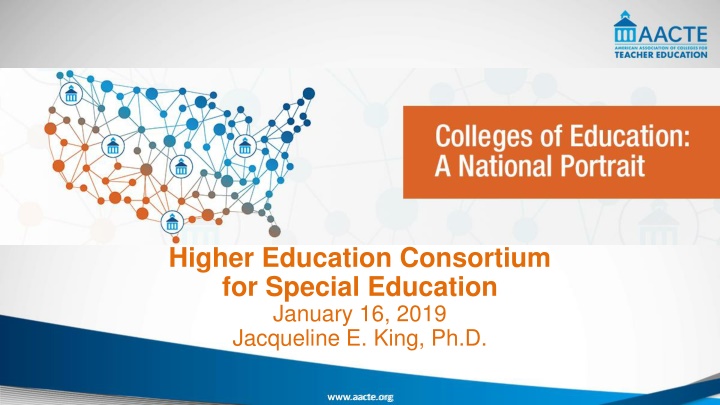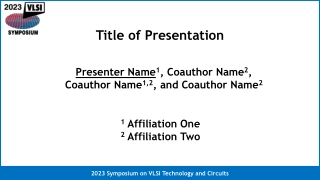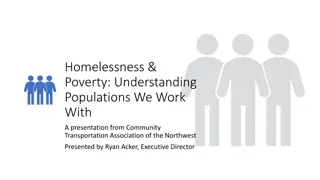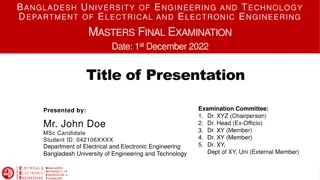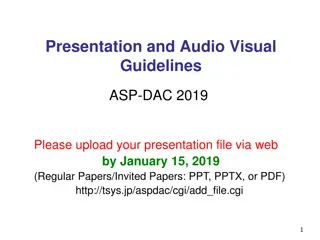Overview of Colleges of Education: Challenges and Contributions
This report explores the role of colleges of education in American education, highlighting their significant contributions through teaching, research, and service. It addresses issues such as diversity among educator candidates, enrollment declines, and faculty retirements, emphasizing the evolving nature of colleges of education. Data sources and completion trends are also discussed, providing insights into the distribution of education degrees conferred. Challenges facing colleges of education are outlined alongside their key contributions to the field.
Download Presentation

Please find below an Image/Link to download the presentation.
The content on the website is provided AS IS for your information and personal use only. It may not be sold, licensed, or shared on other websites without obtaining consent from the author.If you encounter any issues during the download, it is possible that the publisher has removed the file from their server.
You are allowed to download the files provided on this website for personal or commercial use, subject to the condition that they are used lawfully. All files are the property of their respective owners.
The content on the website is provided AS IS for your information and personal use only. It may not be sold, licensed, or shared on other websites without obtaining consent from the author.
E N D
Presentation Transcript
Higher Education Consortium for Special Education January 16, 2019 Jacqueline E. King, Ph.D. www.aacte.org
What is the National Portrait? 1. Describes colleges of education: the work they do, the people who do that work and the students they serve 2. Outlines contributions in teaching, research and service 3. Identifies some of the significant challenges facing colleges of education 2
Definition Not all education programs are housed in a college or school of education. There are no national data that distinguish institutions with a college of education. This report uses the term college of education to refer to all four-year colleges and universities that award degrees or certificates in education at the bachelor s degree level or higher. Whenever two-year or less-than- two-year institutions are discussed, they are referenced explicitly. What is a College of Education in this report? 3
Key Findings Colleges of education make significant contributions to American education through teaching, research, and service. Those preparing to become educators are not as diverse as the students they will serve. Enrollment declines challenge colleges of education to meet all the needs of America s schools. Faculty retirements will present challenges and opportunities as colleges of education evolve. www.aacte.org
Data Sources IPEDS (Integrated Postsecondary Education Data System) Reported by Institutions Counts degrees and certificates conferred by field and specialty (among many other topics) Does not count enrollment by program or major Does not capture students who complete a teacher preparation program but do not earn a degree or certificate in education Title II Data Collection Reported by teacher preparation programs Counts program enrollment and completers Includes non-institutional providers Includes only programs preparing students for initial licensure
Completion Trends www.aacte.org
Distribution of Degrees Conferred in Education Graduate Certificate 7% Associate's 6% Doctoral 4% Bachelor's 31% Master's 49% Undergraduate Certificate 3% www.aacte.org
Completion Trends in Teacher Preparation Programs Number of Program Completers Alternative, Not IHE-based Alternative, IHE- based Traditional All Programs 2007-08 180,574 24,609 18,679 223,862 2015-16 139,443 20,018 12,689 172,150 Percentage Change -23% -19% -32% -23% www.aacte.org
10-Year Trend in Bachelors Degrees by Field 100% 76% 80% 58% 60% 46% 40% 29% 17% 20% 12% 5% 0% -20% -19% -40% Total degrees Humanities Social and behavioral sciences Natural sciences and mathematics Computer sciences and engineering Education Business Other fields 9 www.aacte.org
Mismatch Between Majors and School Needs Teacher Preparation Program Completers Master s Degree Completers High-Need Fields Bilingual Education and English Language Acquisition 4% 5% Foreign Language 2% 1% Math 4% 3% Reading 1% 9% Science 4% 2% Special Education 9% 27% 10 www.aacte.org
Institutions by Number of Degrees Conferred Number of Degrees and Certificates Awarded Percentage of Degrees and Certificates Awarded Number of Institutions More than 1,000 23 16% 500 to 999 119 28% 250 to 499 205 26% 100 to 249 313 18% 50 to 99 281 7% 25 to 49 265 3% Fewer than 25 482 2% All Institutions 1,688 100% 11 www.aacte.org
Bachelors and Masters Degree Trends 200,000 175,000 150,000 125,000 100,000 75,000 50,000 25,000 0 2000-01 1970-71 1972-73 1974-75 1976-77 1978-79 1980-81 1982-83 1984-85 1986-87 1988-89 1990-91 1992-93 1994-95 1996-97 1998-99 2002-03 2004-05 2006-07 2008-09 2010-11 2012-13 2014-15 Bachelor's Degrees Master's Degrees 12 www.aacte.org
Doctoral Degrees by Gender 9,000 8,000 7,000 6,000 5,000 4,000 3,000 2,000 1,000 0 1988-89 1970-71 1972-73 1974-75 1976-77 1978-79 1980-81 1982-83 1984-85 1986-87 Men 1990-91 1992-93 1994-95 Women 1996-97 1998-99 2000-01 2002-03 2004-05 2006-07 2008-09 2010-11 2012-13 2014-15 13 www.aacte.org
Undergraduate Diversity 14 www.aacte.org
Lack of Diversity EDUCATION BACHELOR S DEGREE RECIPIENTS Other Women 3% Other Men 1% White Men 15% Women of Color 15% Other category includes students of more than one race and nonresident aliens. Men of Color 6% White Women 60% 15 www.aacte.org
Education Compared to Other Disciplines BA s Conferred % Non-White All Fields Homeland security, law enforcement, and firefighting Public administration and social services Psychology Multi/interdisciplinary studies Biological and biomedical sciences Computer science Social sciences and history Liberal arts and sciences Family and consumer sciences Business Communication and journalism Health professions and related programs Visual and performing arts Engineering Parks, recreation, leisure, and fitness Physical sciences English Education Agriculture and natural resources 646,566 60,623 34,042 114,546 47,475 110,509 60,321 151,367 42,785 24,898 344,280 89,316 226,267 87,837 96,754 50,074 28,865 42,223 86,275 36,215 40% 46% 45% 41% 40% 40% 39% 38% 37% 35% 35% 34% 33% 32% 32% 32% 29% 29% 22% 19% Business and health professions account for 77% of non- white BA/BS recipients. 16 www.aacte.org
Teacher Preparation Enrollment by Race/Ethnicity Alternative, Institution-based Alternative, Not Institution-based Traditional All Programs White 72% 60% 53% 70% Hispanic 13% 18% 18% 13% African American 8% 14% 22% 9% Asian/Pacific Islander 3% 4% 3% 3% Native American 1% 1% 1% 1% More than one race 3% 3% 2% 3% 100% 100% 100% 100% Total 17 www.aacte.org
Graduate Student Diversity 18 www.aacte.org
Graduate Student Diversity by Degree Type Certificate Master s Doctorate Total White Men Women African American Men Women Hispanic Men Women Race/ethnicity unknown Asian/Pacific Islander Nonresident Alien Two or more races American Indian or Alaska Native Grand Total 67% 17% 50% 12% 2% 9% 6% 1% 5% 9% 2% 2% 2% 0% 100% 64% 15% 49% 10% 2% 8% 10% 2% 8% 8% 3% 3% 2% 1% 100% 57% 18% 38% 18% 4% 13% 8% 3% 6% 6% 4% 6% 1% 1% 100% 64% 15% 48% 11% 2% 8% 9% 2% 7% 8% 3% 3% 2% 1% 100% 19 www.aacte.org
Masters Degree Diversity by Field Degrees Conferred % Non- White All Fields 649,653 33% Computer science Public administration and social services Business 14,820 46% 44,183 42% 153,430 38% Engineering 22,356 34% Psychology 26,557 34% Health professions 106,149 33% Education 141,286 28% 20 www.aacte.org
Doctorate/Professional Diversity by Field Degrees Conferred % Non-White All Fields 156,407 32% Education 11,142 35% Health professions 71,321 33% Legal professions 35,915 30% Engineering 4,495 30% Psychology 6,208 29% Biological and biomedical sciences 5,808 27% Social sciences and history 3,366 22% Physical sciences 3,631 20% 21 www.aacte.org
Special Education www.aacte.org
Institutions Awarding Degrees and Certificates in Special Education Degrees/Certificates Conferred Institutions Bachelor s 425 8,791 Post-BA/Post-MA Certificates 161 2,110 Master s 563 17,480 Doctorates 58 231 Total 797 28,612 www.aacte.org
Largest Specialties Post-BA/Post-MA Certificates Bachelor s Master s Doctorates Total 6,469 828 11,559 198 19,054 Special Education and Teaching, General Early Childhood Special Education Programs 595 63 976 1,634 432 62 1,123 1,617 Elementary Special Education Programs 9 514 843 1,366 Individuals with Autism 340 103 658 13 1,114 Special Education and Teaching, Other Individuals with Specific Learning Disabilities 210 85 308 603 223 340 1 564 Gifted and Talented 29 21 477 527 Secondary Special Education Programs 132 34 309 475 Individuals with Multiple Disabilities 148 42 261 451 Speech or Language Impairments 24 www.aacte.org
Institutions by Number of Special Education Degrees/Certificates Awarded Percentage of All Degrees/Certificates Awarded Number of Institutions Degrees/Certificates Awarded 500 or more 5 15% 250 to 499 5 5% 100 to 250 40 21% 50 to 100 114 27% 25 to 50 138 17% 10 to 25 210 11% Fewer than 10 285 4% Total 797 100% 25 www.aacte.org
Institutions that Award the Most Degrees/Certificates in Special Education Institution Name Degrees/Certificates Awarded Grand Canyon University 1,234 Ball State University 960 Touro College 943 Western Governors University 580 Liberty University 518 CUNY Hunter College 351 George Mason University 330 National University 282 Arkansas State University-Main Campus 267 Slippery Rock University of Pennsylvania 263 26 www.aacte.org
Institutions that Awarded the Most Doctorates in Special Education in 2016-17 Institution Name Doctorates Awarded University of Northern Colorado 11 Teachers College at Columbia University 11 Vanderbilt University 10 University of Florida 9 University of Nevada-Las Vegas 8 Utah State University 8 Illinois State University 7 George Washington University 7 University of Oregon 7 University of Washington-Seattle Campus 7 27 www.aacte.org
Special Education Degree/Certificate Recipients by Race/Ethnicity Post-BA/Post-MA Certificates Bachelor's Master's Doctorate Total 81% 73% 80% 67% 76% White 4% 9% 8% 6% 8% African American 10% 11% 5% 6% 10% Hispanic 1% 3% 4% 4% 2% Asian/Pacific Islander 0% 0% 1% 1% 0% American Indian/Alaska Native 2% 2% 1% 0% 2% Two or more races 0% 2% 2% 16% 1% Nonresident Alien Total 100% 100% 100% 100% 100% 28 www.aacte.org
Coming Soon Education Students and Diversity: A Review of New Evidence (February 2019) Degree Trends in Areas of Teacher Shortage (Release TBD) 29 www.aacte.org
Questions & Discussion 30 www.aacte.org
